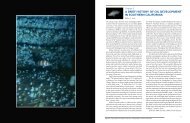checklist (pdf) - The Love Lab - University of California, Santa Barbara
checklist (pdf) - The Love Lab - University of California, Santa Barbara
checklist (pdf) - The Love Lab - University of California, Santa Barbara
Create successful ePaper yourself
Turn your PDF publications into a flip-book with our unique Google optimized e-Paper software.
(Mecklenburg et al. 2002, Sheiko and Mecklenburg 2004). At depths <strong>of</strong> 7–520 m (23–1,706 ft; Sheiko<br />
and Fedorov 2000); less than 100 m <strong>of</strong>f Alaska (Mecklenburg et al. 2002). Sometimes seen spelled olriki,<br />
but the original, correct spelling is olrikii. <strong>The</strong> correct date for the species description is 1877, although<br />
sometimes seen as 1876 (Sheiko and Mecklenburg 2004).<br />
Xeneretmus latifrons (Gilbert, 1890). Blacktip Poacher. To 19.0 cm (7.5 in) TL (Miller and Lea 1972). Adults<br />
from Rennell Sound and Skidegate Channel, British Columbia (Mecklenburg et al. 2002) to Punta<br />
Colnett, northern Baja <strong>California</strong> (Fitch and Lavenberg 1968). <strong>The</strong> presence <strong>of</strong> larvae in the northern<br />
Gulf <strong>of</strong> Alaska indicates adults are also present there (Matarese et al. 2003). At depths <strong>of</strong> 2 m (7 ft) or less<br />
to 1,291 m (4,235 ft) (min.: Miller et al. 1980 and UW 2915 [beach seine]; max.: SIO 75-473).<br />
Xeneretmus leiops Gilbert, 1915. Smootheye Poacher. To 27 cm (10.8 in) TL (Barraclough and Peden 1976).<br />
West <strong>of</strong> Forrester Island, southeastern Alaska (Peden and Jamieson 1988) to <strong>Santa</strong> Catalina Island, southern<br />
<strong>California</strong> (Miller and Lea 1972). At depths <strong>of</strong> 37–399 m (122–1,308 ft; Eschmeyer and Herald 1983).<br />
Xeneretmus ritteri Gilbert, 1915. Stripefin Poacher. To 15.9 cm (6.25 in) TL (Miller and Lea 1972). Malibu,<br />
southern <strong>California</strong> to Isla Cedros, central Baja <strong>California</strong>; isolated population in northern Gulf <strong>of</strong><br />
<strong>California</strong> (Miller and Lea 1972). At depths <strong>of</strong> 105–366 m (344–1,200 ft) (min.: Allen et al. 2002; max.:<br />
Miller and Lea 1972).<br />
Xeneretmus triacanthus (Gilbert, 1890). Bluespotted Poacher. To 17.8 cm (7 in) TL (Jordan and Evermann<br />
1898). Kwatna Inlet, British Columbia (Peden and Gruchy 1971) to Punta Baja, northern Baja <strong>California</strong><br />
(Leipertz 1985). At depths <strong>of</strong> 15–429 m (49–1,407 ft) (min.: Fay et al. 1978; max.: Shaw et al. 2000).<br />
Family Cyclopteridae — Lumpfishes or Lumpsuckers<br />
Lumpsuckers are sometimes called lumpfishes after an Atlantic coast species called the Lumpfish (Cyclopterus<br />
lumpus).<br />
Aptocyclus ventricosus (Pallas, 1769). Smooth Lumpsucker. To 42 cm (16.5 in) TL. Japan and Okhotsk seas<br />
to Providence Bay, Gulf <strong>of</strong> Anadyr; and northern Bering Sea, Alaska to North Pacific south <strong>of</strong> Aleutian<br />
Islands and Gulf <strong>of</strong> Alaska to Mathieson Channel, British Columbia. Pelagic; usually found in deep<br />
waters from near surface to depth <strong>of</strong> more than 500 m (1,650 ft; Mecklenburg et al. 2002); taken in<br />
a bottom trawl towed at 1,556 m (5,104 ft), but the fish may have entered the net above the bottom<br />
(H<strong>of</strong>f and Britt 2003). Boris A. Sheiko (pers. comm. to C. W. M.) reports that in the Okhotsk Sea A.<br />
ventricosus are frequently caught by pelagic trawl nets towed in the open sea from 1,000 to 500 m, as well<br />
as from 500 to 200 m and 200 m to the surface. Kido and Shinohara (1996) showed that the form named<br />
Pelagocyclus vitiazi Lindberg & Legeza, 1955, is the juvenile stage <strong>of</strong> A. ventricosus.<br />
*Cyclopteropsis lindbergi Soldatov, 1930. Lindberg’s Lumpsucker. To 7.4 cm (2.9 in) TL. Sea <strong>of</strong> Japan <strong>of</strong>f<br />
Korean Peninsula to Sea <strong>of</strong> Okhotsk and western Bering Sea (Mecklenburg et al. 2002); one probable<br />
record, still under study, from the Aleutian Islands south <strong>of</strong> the Islands <strong>of</strong> Four Mountains, Alaska<br />
(C. W. M., unpubl. data). At depths <strong>of</strong> 49–118 m (161–387 ft; Mecklenburg et al. 2002). May be a junior<br />
synonym <strong>of</strong> Cyclopteropsis bergi Popov, 1929, and may more appropriately be classified in Eumicrotremus<br />
(Mecklenburg and Sheiko 2003).<br />
Eumicrotremus andriashevi Perminov, 1936. Pimpled Lumpsucker. To 9.7 cm TL (3.8 in) Mecklenburg et<br />
al. 2002). Karaginskiy Bay, western Bering Sea to northeastern Chukchi Sea and to eastern Bering Sea<br />
as far south as St. Matthew Island (Mecklenburg and Sheiko 2003). At depths <strong>of</strong> 20–83 m (66–274 ft;<br />
Mecklenburg et al. 2002). Specimens from the Okhotsk Sea and Kuril Islands previously attributed to E.<br />
andriashevi represent the western Pacific forms Eumicrotremus schmidti Lindberg & Legeza, 1955, and<br />
Eumicrotremus fedorovi Mandrytsa, 1991, respectively. Conversely, many specimens from the northeastern<br />
Bering Sea, Alaska, recorded as E. orbis are E. andriashevi (Mecklenburg and Sheiko 2003).<br />
99




